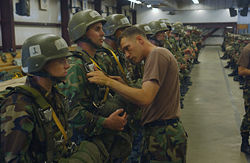
United States Army Airborne School
Encyclopedia

Paratrooper
Paratroopers are soldiers trained in parachuting and generally operate as part of an airborne force.Paratroopers are used for tactical advantage as they can be inserted into the battlefield from the air, thereby allowing them to be positioned in areas not accessible by land...
(military parachutist) training for the United States armed forces
United States armed forces
The United States Armed Forces are the military forces of the United States. They consist of the Army, Navy, Marine Corps, Air Force, and Coast Guard.The United States has a strong tradition of civilian control of the military...
. It is operated by the 1st Battalion (Airborne), 507th Infantry, United States Army Infantry School
United States Army Infantry School
The United States Army Infantry School is located in Fort Benning, Georgia. It is made up of the following components:*192d Infantry Brigade...
, Fort Benning
Fort Benning
Fort Benning is a United States Army post located southeast of the city of Columbus in Muscogee and Chattahoochee counties in Georgia and Russell County, Alabama...
, Georgia
Georgia (U.S. state)
Georgia is a state located in the southeastern United States. It was established in 1732, the last of the original Thirteen Colonies. The state is named after King George II of Great Britain. Georgia was the fourth state to ratify the United States Constitution, on January 2, 1788...
. The Airborne School conducts the Basic Airborne Course, which is open to troops of both genders from all branches of the United States Department of Defense
United States Department of Defense
The United States Department of Defense is the U.S...
and allied military personnel.
The purpose of the Basic Airborne Course is to qualify the volunteer (all students volunteer for this school) in the use of the parachute
Parachute
A parachute is a device used to slow the motion of an object through an atmosphere by creating drag, or in the case of ram-air parachutes, aerodynamic lift. Parachutes are usually made out of light, strong cloth, originally silk, now most commonly nylon...
as a means of combat deployment and to develop leadership, self-confidence, and an aggressive spirit through mental and physical conditioning.
The course is three weeks long and consists of "Ground Week", "Tower Week" and "Jump Week". Rigorous physical training (PT) is emphasized throughout the entire course. The initial entry PT test consists of the standard Army Physical Fitness Test (APFT). All age groups must pass this test using the 17—21 age group standards. The pullup requirement was lifted in October 2006.
History
The Idea for the creation of the airborne program as well as the school, was derived from watching the smokejumpers train at the smokejump center in Missoula, Montana. After seeing the effectiveness of the jumpers, the idea was pitched the the higher ups in DC.Ground Week
During Ground Week, students begin an intensive program of instruction on how to properly wear the T-10D and T-11 parachutes to build individual airborne skills, which prepares them to make five parachute jumps, and five safe landings. They train on a mock door of a C-130 or C-17 aircraft to prepare themselves for a proper exit from each aircraft. Students also learn and practice the parachute landing fall (PLF), a landing technique specifically developed to ensure a safe landing for personnel as they impact the ground while wearing a parachute. Students train to exit the 34 feet (10.4 m) tower, which prepares them for a safe exit from an aircraft in flight by exposing the students to the physical sensation of an actual jump. Students train on the lateral drift apparatus (LDA) to develop proper technique for controlling a parachute during descent. To progress to Tower Week, students must individually qualify on the 34 feet (10.4 m) tower, the LDA, successfully complete all PLFs, and pass all PT requirements.Tower Week
A team effort is added to the training with the "mass exit" concept. Here students will learn the proper technique to exit an aircraft in flight in mass quantity. Students are informed of proper in flight instructions given before a jump. Students are also trained on the 34' tower with all equipment that will be used on the jumps. On the 34' tower they get a chance to work on exiting the aircraft with all their equipment and also lowering their equipment prior to landing. The last 2 days of the week are used qualifying on the Swing Landing Trainer (SLT) and practicing on the suspended harness. If weather permits, students will attempt 1 drop on the 250' tower on the last day of the week. The apparati used this week are the 250' and 34' towers, the swing landing trainer (SLT), the mock door for mass exit training, and the suspended harness. To successfully move on to Jump Week students must demonstrate an understanding of in flight instructions, "mass exit" techniques, proper exits from the 34' tower, and successfully perform all PLF's on the Swing Landing Trainer.Jump Week
During Jump Week students make five parachute jumps into Fryar Drop Zone (DZ) located in Alabama, which is part of the Fort Benning Military Reservation. Trainees must run to the air field, conduct pre-jump training, and then get into their harnesses and await their turn to jump. Generally, the first two jumps are "hollywood", in that the jumper only wears the parachute and reserve. The remaining three jumps are "combat equipment jumps", in which the jumper carries a ruck sack and a dummy weapon. At least one jump, typically the last, is required to be at night. It is possible due to weather and other factors, such as holidays, a student may have all five jumps during daylight hours.Instructors

Dress uniform
Dress uniform , is the most formal military uniform, typically worn at ceremonies, official receptions, and other special occasions; with order insignias and full size medals...
rank insignia and parachutist badge
Parachutist Badge (United States)
The Parachutist Badge, also commonly referred to as "Jump Wings" or "Snow Cone", is a military badge of the United States Armed Forces awarded to members of the United States Army, Air Force, Marine Corps and Navy...
that is the distinguishing part of their uniform. However, all students within the school are required to call them "Sergeant Airborne" (or Petty Officer
Petty Officer
A petty officer is a non-commissioned officer in many navies and is given the NATO rank denotion OR-6. They are equal in rank to sergeant, British Army and Royal Air Force. A Petty Officer is superior in rank to Leading Rate and subordinate to Chief Petty Officer, in the case of the British Armed...
Airborne in case of a Navy instructor). Unusual for an Army school, instructors may come from the United States Army
United States Army
The United States Army is the main branch of the United States Armed Forces responsible for land-based military operations. It is the largest and oldest established branch of the U.S. military, and is one of seven U.S. uniformed services...
, Marine Corps
United States Marine Corps
The United States Marine Corps is a branch of the United States Armed Forces responsible for providing power projection from the sea, using the mobility of the United States Navy to deliver combined-arms task forces rapidly. It is one of seven uniformed services of the United States...
, Navy
United States Navy
The United States Navy is the naval warfare service branch of the United States Armed Forces and one of the seven uniformed services of the United States. The U.S. Navy is the largest in the world; its battle fleet tonnage is greater than that of the next 13 largest navies combined. The U.S...
or Air Force
United States Air Force
The United States Air Force is the aerial warfare service branch of the United States Armed Forces and one of the American uniformed services. Initially part of the United States Army, the USAF was formed as a separate branch of the military on September 18, 1947 under the National Security Act of...
. The reasoning behind this is because students from four branches of the military are able to attend, so each branch insists that they have at least one representative to ensure quality instruction. They train students in the use of static line deployed parachutes. The U.S. Coast Guard does not usually participate in Airborne training as it does not directly relate to the branch's duty of Homeland Security and their daily search and rescue missions.
The battalion is organized into six companies: Headquarters and Headquarters Company (HHC) for administrative actions and command and control; four Line Companies (A, B, C, and D) execute the Basic Airborne Course Program of Instruction (POI) and Company (E) provides parachute rigger
Parachute rigger
A parachute rigger is a person who is trained or licensed to pack, maintain or repair parachutes. A rigger is required to understand fabrics, hardware, webbing, regulations, sewing, packing, and other aspects related to the building, packing, repair, and maintenance of parachutes.- Military...
support. D company has been disbanded in recent times and a week long buffer between class cycles occurs.
Students
The vast majority of students at Airborne School come from the U.S. Army. These include soldiers on assignment to the 82nd Airborne Division, XVIII Airborne Corps, 4th BCT 25th Infantry Division, 173rd Airborne BCT, 75th Ranger Regiment75th Ranger Regiment (United States)
The 75th Ranger Regiment , also known as Rangers, is a Special Operations light infantry unit of the United States Army. The Regiment is headquartered in Fort Benning, Georgia with battalions in Fort Benning, Hunter Army Airfield and Joint Base Lewis-McChord...
, or the Special Forces Qualification Course. Also Marine Recon units as well as ANGLICO Units attend. Recent BUD/S
United States Navy SEAL selection and training
The average United States Navy SEAL spends over a year in a series of formal training environments before being awarded the Special Warfare Operator Naval Rating and the Navy Enlisted Classification 5326 Combatant Swimmer or, in the case of commissioned naval officers, the designation Naval...
graduates, USAF Combat Controllers, USAF Special Operations Weather Technicians
Air Force Special Operations Weather Technician
Special Operations Weather Team specialists are tactical observer/forecasters with ground combat capabilities and fall under the 720th Special Tactics Group within the Air Force Special Operations Command...
,USAF Pararescuemen and Tactical Air Control Party (TACP) also attend the school in order to be jump qualified. Summer classes are frequently made up of substantial numbers of cadets from ROTC
Reserve Officers' Training Corps
The Reserve Officers' Training Corps is a college-based, officer commissioning program, predominantly in the United States. It is designed as a college elective that focuses on leadership development, problem solving, strategic planning, and professional ethics.The U.S...
and West Point
United States Military Academy
The United States Military Academy at West Point is a four-year coeducational federal service academy located at West Point, New York. The academy sits on scenic high ground overlooking the Hudson River, north of New York City...
. The United States Army Parachutist Badge
Parachutist Badge (United States)
The Parachutist Badge, also commonly referred to as "Jump Wings" or "Snow Cone", is a military badge of the United States Armed Forces awarded to members of the United States Army, Air Force, Marine Corps and Navy...
(commonly referred to as "Jump Wings") is awarded to U.S. Armed Forces personnel upon completion of Airborne School regardless of branch or MOS.
Upon arrival, students are given roster numbers which must be put on their equipment. Since military rank is not taken away during training, enlisted, cadets, NCOs, and officers are distinguished by a plain number, C, N, or A placed in front of their roster number, respectively.

